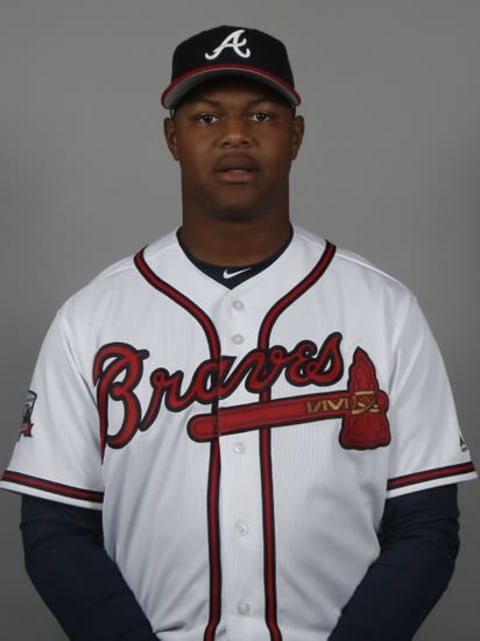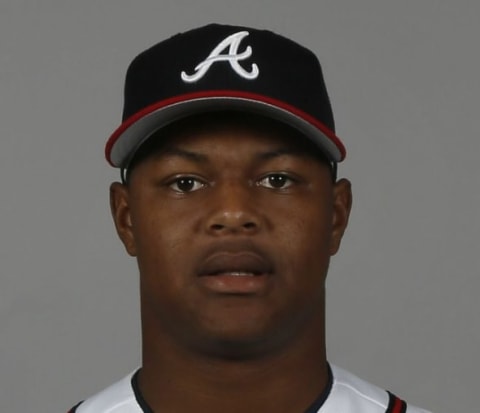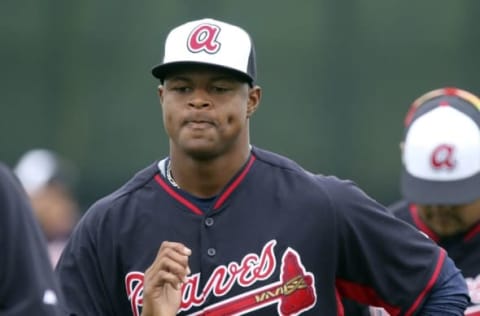Atlanta Braves top 100 Prospects: #55 Mauricio Cabrera


Atlanta Braves Right Hander Mauricio Cabrera
Who Is He?
The Braves signed Cabrera out of the Dominican Republic in 2010. He started in the Dominican Summer League in 2011, making 19 appearances, 9 of them starts, throwing 52 1/3 innings with a 4.30 ERA, 1.43 WHIP, and 24/36 BB/K ratio. His control needed work, but the pure velocity drew definite notice.
The Braves brought Cabrera state side to advanced-rookie Danville in 2012. He made 12 starts, pitching 57 2/3 innings, posting a 2.97 ERA, 1.18 WHIP, and 23/48 BB/K ratio. He climbed up a ton of Braves rankings. John Sickels ranked him #6 in the system, as did Baseball America, while Baseball Prospectus rated Cabrera #4 in the Braves system.
Cabrera threw for his full-season league with Rome in 2013. He made 24 starts, throwing 131 1/3 innings, posting a 4.18 ERA and 1.44 WHIP, but with a notably poor 71/107 BB/K.
The Braves moved the 20 year-old Cabrera to high-A Lynchburg to start 2014, and the control finally caught up to him, with a simply putrid performance. He was even sent to the Gulf Coast League team in an attempt to get him right. Overall, he posted a 5.73 ERA between the two levels over 22 appearances (5 of them starts) spanning 33 innings. He posted a 1.46 WHIP and a 21/31 BB/K ratio.
Next: Cabrera's scouting report
Cabrera was moved full-time to the bullpen in 2015. He started the season with high-A in Carolina and finished with Mississippi. His numbers were uninspiring, posting a 5.59 ERA and 1.59 WHIP over his 36 games and 48 1/3 innings with a 35/53 BB/K. His velocity was eye popping, but the fastball was often straight. The Braves sent him to the Arizona Fall League, and he turned heads with the fastest pitches of the entire league, topping out at 102mph. His numbers, however, were still poor in the AFL with a 6.17 ERA and 1.80 WHIP over 9 appearances and 11 2/3 innings with a a 7/15 BB/K ratio.

Scouting Report
More from Tomahawk Take
- Atlanta Braves Swing Trade with the New York Yankees for Lucas Luetge
- Atlanta Braves 2012 Top Prospects Review: Zeke Spruill
- Braves News: Atlanta extends Sean Murphy, pitcher reunions, more
- Atlanta Braves: Six Braves prospects that could debut in 2023
- Braves News: Braves sign Sean Murphy to six year, $73 million deal
In wanting to get a good look at Cabrera, I took a look at two games from each full month of the season, catching 10 games. In those 10 games, Cabrera threw 13 innings, with a 7.62 ERA, 2.00 WHIP, and 10/18 BB/K ratio.
Cabrera is listed by B-Ref as 6’3 and 230 pounds. He’s certainly all of that, and he looks quite thick on the mound. He has moved to pitching exclusively out of the stretch. He has a slow, steady motion, with a knee lift with a glove lift, but then he explodes to the plate with an arm slot below 3/4 but above side arm. He really looks to be slinging the ball toward the plate, holding his arm high and extended through the motion until release.
Cabrera’s well known for his fastball, which has ranged up past triple digits, but he also utilizes a slider and a change up. The fastball really runs with minimal movement. The issue is that Cabrera has neither command nor control of the fastball. The slinging motion of his arm leads to him sometimes getting on top of the ball from that arm slot and sometimes “flinging” the ball nearly sidearm, even though the release point seems to stay consistent. That inconsistency in his arm motion within the pitch motion really does him no favors in commanding the fastball. Going through Brooks Baseball to look at his heat map will show exactly that. Cabrera has the two highest frequency of pitches thrown in the upper left part of the zone and the lower right part of the zone with pitches scattered all over the zone.
The slider is his bread and butter second pitch, though what I found interesting is the velocity range I saw the pitch. He had a pitch clocked at 85 in one game and two batters later, the same break came in at 72. That’s an incredible range in velocity for the pitch. He does seem to have good location on the pitch, getting consistently on top of the pitch to throw it consistently, from the same arm slot as his fast ball, but never with the “flinging” motion you see sometimes in the fastball. He did not throw many of these in the AFL for review on Brooks Baseball, but in the games I saw, it has a nice straight break and sometimes will run arm side toward the toes of the right handed hitter.
Next: 2016 outlook
The AFL was definitely where he was working on his change up, as he threw 22 change ups versus 7 sliders. During the season, the ratio was about 4 sliders for every 3 change ups, so to have the ratio that skewed in his AFL data really is intriguing. The change up also is susceptible to the flinging motion in his arm, and therefore, also has the same command and control issues. His AFL heat map looks like he really used the late break of his change, which does have some splitter motion to it, to pitch down to the arm side mostly with the pitch (10 of 22 pitches in the bottom three boxes of the 5×5 Brooks Baseball zone). If he could use the pitch in that way, I could see it becoming much more effective, but his command issues with it has led to that pitch really getting hit hard.

2016 Outlook
Cabrera’s arm motion allows his high velocity to be “visible” for an exceptionally long time for both sides of the plate. When he’s missing his spots, he can begin “aiming” to get the pitch over, and all of the sudden, he’s throwing a high-90s pitch into the meat of the zone, and pitchers up in the minors and certainly in the majors will drive that ball to no end. His future relies 100% on his ability to command his pitches as his arm motion, and his ability to keep his hand on top of the ball rather than flinging the ball. Cabrera’s velocity is something you don’t just teach, but the Braves now have as many as a handful of guys who can match Cabrera’s top end velocity, so it’s not something that the organization needs to hoard for scarcity in the organization.
Next: Braves Top 100 Prospects Updated
Cabrera will most likely return to Mississippi, and if he can work the change low in the zone, stay on top of his fastball and change, and throw with command and velocity both, he’ll explode up the system to Atlanta. So far, that’s been the struggle is maintaining the velocity while also keeping the ball in zone, so we’ll keep an eye on his progress as that velocity certainly is valuable if he can keep it in the zone, but as we’ve seen recently with guys like Juan Jaime, just throwing the ball really, really hard doesn’t mean there’s value to a major league bullpen.